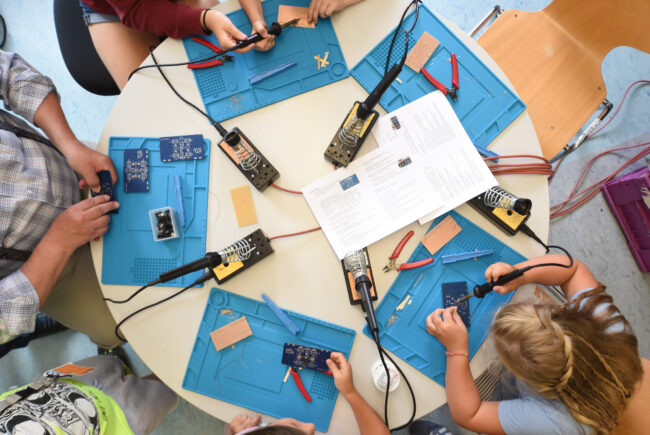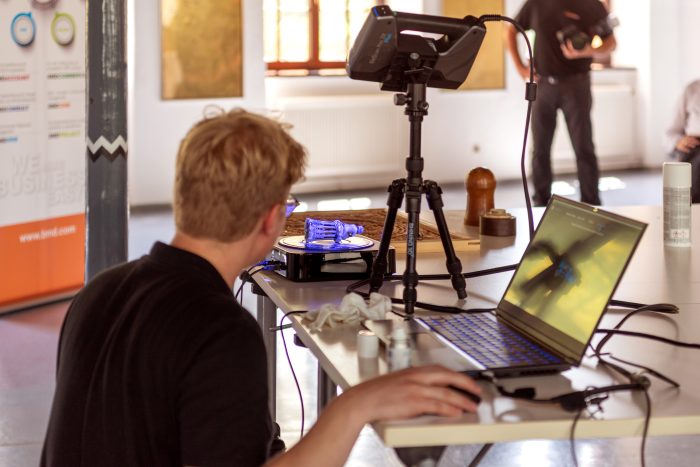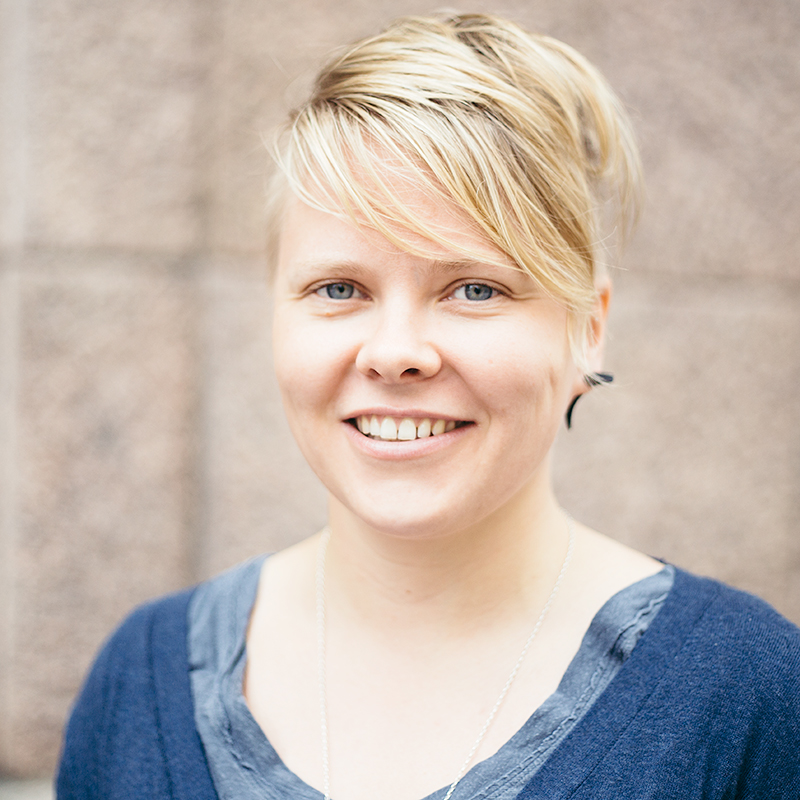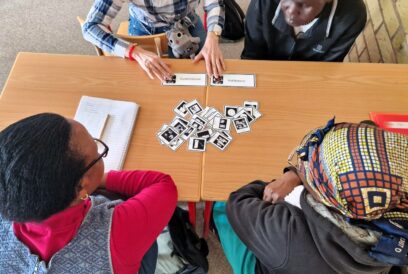

For many makers, being a part of group or community means trying out new approaches, listening to the ideas of others and working together to tackle challenges. Photo: Tobias Zachl
For many makers, being a part of group or community means trying out new approaches, listening to the ideas of others and working together to tackle challenges. Photo: Tobias Zachl
We talked to people involved in maker communities across Europe. Whatever the activity is, being creative together is what really matters.
Torunn Elise Kveen, Norway:
“Our courses combine learning a new handicraft, dance or theatre with the everyday use of the Norwegian language. Setting up a course in Norwegian is quite natural for craft organisations, since handicraft is known by many, there is a low threshold for trying it out, and it creates a safe environment for discussion when working with your hands.
The handicraft and arts courses are run as regular courses – they just have an extra emphasis on words and expressions tied to the topics around the craft or activity. As soon as the course starts, the discussion develops into a tree of thousand branches.
- The open-for-all project is funded on the idea of creating meeting places for newcomers in Norway who want to work on their Norwegian language, Norwegian culture and to get to know people
- The In Norwegian courses are organised by the Association for Studies of Culture and Tradition and their member organisations, and they aim for integration and inclusion.
- Torunn Elise Kveen is an information advisor for Norwegian language courses at the Association for Studies of Culture and Tradition in Norway.
The courses also offer learning to native Norwegian speakers. I might be learning a technique on the same level as everyone else around the table, but I would be placed in between people who do not speak Norwegian as their mother tongue, as I do. My conversation with them would be part of my contribution.
It is very interesting to take part in these courses and experience meeting all these people from various countries around the world. We discuss topics such as culture, politics, democracy, war and global news.
In one of our groups, we had a very sweet, old lady from Eritrea, who brought her two daughters along. The very first night, she told us she neither spoke nor understood Norwegian, but we could see that behind her knitting she was really following the conversation closely, laughing at natural spots.
It took her just a couple of nights to open up and start talking. We realised that she was probably one of those sitting in a language class saying nothing. But she knew knitting, and a lot about handicrafts, and she ended up being a very visible and active member of the group.

The In Norwegian courses are organised by the Association for Studies of Culture and Tradition and their member organisations, and they aim for integration and inclusion. Photo: Photo: Torunn Elise Kveen
We have schools taking care of whatever needs to be learned behind a desk. Our courses are for people who want to be part of the herd, the group and their community, for them to see and experience the language being used in its natural context. Here the newcomers are part of something and they also contribute, not just receive.
We want our member organisations to really think about how to be better at inclusion and integration in their work. How to really make it an integrated part of their way of thinking.
We encourage people to consider who in their area could be possible members of our group; not just people new to our country, but those who would not necessarily attend without being invited. The organisers do active research to get participants from the local communities to attend our courses.
Five years ago, with the In Norwegian courses, we started out having two pilot courses, one for handicraft and one for theatre. This year we are holding 30 courses around Norway. In three years, our goal is to hold 120 courses through this project.”
Margaret Browning, Ireland:
“Before being introduced to CycleUp, I had been coming to the RWN writing group for years. I had never even used a sewing machine before but was very interested in the idea of upcycling. I hate throwing things out and was curious to learn ways to reuse materials and products that might otherwise go to waste.
During the introductory CycleUp training, our group got on very well and we decided to stick together. Our first big project was designing and completing 120 fabric crabs for an international marine conservation congress, as the organisers wanted some ethically sourced souvenirs for the event.
CycleUp sources unsold textiles from the Roscommon Women’s Network Charity Shop to make most of its upcycled items. Old colourful shirts were the primary textile we used for the fabric crabs order.
- CycleUp trains individuals and groups in the repair and reuse of materials and produces upcycled items for sale as part of the circular economy. The program empowers women to participate in environmental protection but also provides skills and
training for flexible paid employment in a rural county. - CycleUp is a part of Roscommon Women’s Network (RWN), a multi-faceted initiative to support women and their families throughout Roscommon County in Ireland.
- Margaret Browning is one of the trained upcycling tutors, designing and delivering upcycling workshops to others.
As more commissions and orders came in, we approached the work as a team and learned a lot about the process of upcycling in large volumes from each other. During the lockdown we were making a lot of textile facemasks for donation to refugee centres and care homes, for example. These facemasks were made from seconds and offcut textiles offered to us by curtain and bedding outlets.
When I was offered the opportunity to train to become a tutor, I was initially a little hesitant. During the pandemic, the training course took place on Zoom and I am not a technical person at all. But in the process, I ended up learning new computer skills as well.
It has felt really rewarding to be able to pass on the skills I learned to others. When I was training a group of Syrian refugees, for example, there was a bit of a language barrier, but it was clear that everyone was enthusiastic about learning, so it wasn’t really a problem.
I am really happy I don’t have to do the training alone. There are always two of us, which makes it a lot more fun. I feel that what we are rather providing support than giving traditional teaching, which has always felt rigid and unnatural to me.
It means a lot to me to be a part of this group. I am still constantly learning new technical skills but what I enjoy the most is the troubleshooting – trying out new approaches, listening to the ideas of others and working together to tackle challenges.”
Tobias Zachl, Austria:
“We only have two rules. You must be able to carry the objects you wish to be repaired. Secondly, you must at least stay and watch the repair process as we are not a repair company.
People come in to save money but also for a sustainable lifestyle. Common goods coming for repair are garments, electronics, toys and household appliances. People get help with their gadgets from an instructor and also help each other in problem-solving.
- Steyr-Werke is a volunteer organisation running a makerspace with wood and metal workshops, 3D printing and laser cutting possibilities, and 200 m2 of space to work with others on building and repair projects.
- Once a month, Steyr-Werke opens its doors to non-members as well, inviting everyone to come and conserve resources, and pass on know-how by repairing things at a repair café.
- Steyr-Werke also organises workshops for school classes and companies and provides space, for example, for organisations retraining the unemployed.
- Tobias Zachl is the founder and spokesperson of Steyr-Werke.
People are more motivated to repair things themselves after visiting the repair café. They find out that things are often fairly easy, and fixing does not require tremendous knowledge; it is more about trying. And the things are broken anyway, so there is not much to lose!
Our makerspace has around 70 members. The oldest member, an 80-year-old with an interest in 3D-printing, has been part of the club since the beginning in 2016.
We started with a group of men and getting women to join has been difficult. Technical things seem to be a natural barrier to women and groups of men are not the greatest thing to attract women to come and see what is going on. We have tried and now we do have female members, but not too many.

Steyr-Werke is a volunteer organisation running a makerspace with wood and metal workshops, 3D printing and laser cutting possibilities, and 200 m2 of space to work with others on building and repair projects Photo: Tobias Zachl
I think creating a community starts from premises that are planned and designed together and a create relaxed atmosphere. We try to build the space for people to feel comfortable, not just to work on technical things and then leave. Ideas happen when you are feeling good.
Many of the members support the idea of a makerspace, even financially, when they are not using the space themselves for one reason or another. I feel that, in addition to having a place to work on their projects, members of Steyr-Werke value being part of a community of like-minded people.
The network of members is big and includes specialists with different technical interests. Collaboration usually starts with a request for help, but often leads to joint projects done by two or three people with the same interests – or different interests altogether.”
Author







